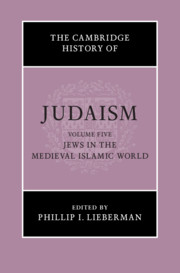Book contents
- The Cambridge History of Judaism
- The Cambridge History of Judaism
- The Cambridge History of Judaism
- Copyright page
- Contents
- Figures
- Acknowledgments
- Introduction
- Part I Jews in the Medieval Islamic World
- Part II Social and Institutional History
- Chapter 11 Demography and Migrations
- Chapter 12 Economic Activities
- Chapter 13 Jewish Religious and Communal Organization
- Chapter 14 Schools and Education
- Chapter 15 The Life Cycle and the Annual Cycle in Genizah Society
- Chapter 16 Family Life in Genizah Society
- Part III Spiritual and Intellectual History
- Index
- References
Chapter 13 - Jewish Religious and Communal Organization
from Part II - Social and Institutional History
Published online by Cambridge University Press: 21 August 2021
- The Cambridge History of Judaism
- The Cambridge History of Judaism
- The Cambridge History of Judaism
- Copyright page
- Contents
- Figures
- Acknowledgments
- Introduction
- Part I Jews in the Medieval Islamic World
- Part II Social and Institutional History
- Chapter 11 Demography and Migrations
- Chapter 12 Economic Activities
- Chapter 13 Jewish Religious and Communal Organization
- Chapter 14 Schools and Education
- Chapter 15 The Life Cycle and the Annual Cycle in Genizah Society
- Chapter 16 Family Life in Genizah Society
- Part III Spiritual and Intellectual History
- Index
- References
Summary
Inherent in this provision is the notion that law was personal rather than territorial, that individuals were governed – at least with respect to civil matters – by the regulations of their respective religious communities, and not by a universally applied legal system. This chapter examines the authority structures that were maintained by the medieval Jewish community, and through which this fundamental dispensation was put into practice. Out of necessity, it focuses primarily on the two and a half centuries between 1000 and 1250, the period for which we have the most abundant sources.
- Type
- Chapter
- Information
- The Cambridge History of Judaism , pp. 450 - 483Publisher: Cambridge University PressPrint publication year: 2021

